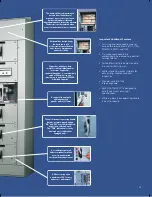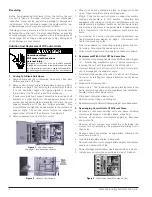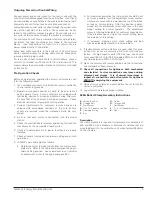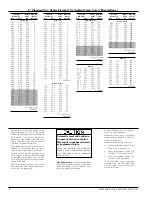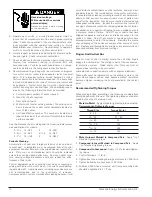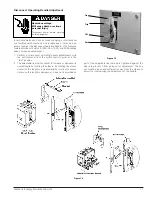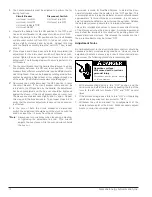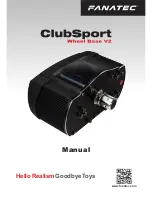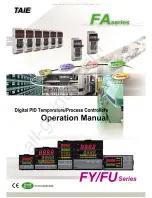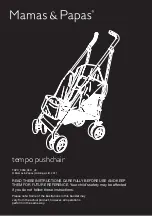
10
Siemens Energy & Automation, Inc.
5. Operate each switch or circuit breaker several times to
insure that all mechanisms are free and in proper working
order. Check the operation of the mechanical safety inter-
locks provided with the operator (see section on Circuit
Breaker/Disconnect Operator). Never attempt to operate a
switch or circuit breaker by use of excessive force.
6. Visually inspect instruments and pilot lights. Replace defec-
tive pilot lights. Check instrument calibrations.
7. Check all devices for missing or broken parts, proper spring
tension, free movement, rusting or corrosion, dirt, and
excessive wear. Perform periodic maintenance on compo-
nents as detailed in the component instruction books.
8. Recommended to go along with the maintenance program
for a motor control center is an adequate stock of renewal
parts. This is important where service becomes a critical
factor or downtime is extremely expensive. The items kept
in stock will depend on the type of motor control center and
its application. Typical items kept in stock should include
contact kits, magnet coils, and fuses. When ordering renew-
al parts, the following information must be provided.
a Complete part numbers of items required.
b Quantity of parts required.
c Description of parts.
d Motor control center catalog number. The catalog num-
ber is found on the control center nameplate located on
front of the center.
e Unit identification number. The number is located on a
label on the side of the control unit for which the ordered
parts are needed.
See the Siemens control catalog and the following replacement
part publications for starters.
0 - 1
3
/
4
14 - GCF
4
14 - GJB
2 - 2
1
/
2
14 - GFF
4
1
/
2
- 5
14 - GKF
3 - 3
1
/
2
14 - GHF
6
14 - GMF
Periodic Cleaning
Accumulation of dust and foreign material such as coal dust,
cement dust, or lampblack must be removed from all control
equipment and all surfaces must be wiped clean at regular inter-
vals. Dirty, wet, or contaminated parts should be replaced
unless they can be cleaned effectively. Dust can collect mois-
ture, causing voltage breakdown and it can reduce the effec-
tiveness of heat sinks.
Control equipment parts should be cleaned by vacuuming or
wiping with a dry cloth or soft brush. Use care to avoid damag-
ing delicate parts. Liquid cleaners, including spray cleaners, are
not recommended due to the possibility of residues.
Compressed air is not recommended for cleaning because it will
only distribute contaminants on other surfaces, and may dam-
age delicate parts. The inside bottom of the motor control cen-
ter should also be cleaned, including removal of any hardware or
debris, so that any new or unusual wear or loss of parts occur-
ring after the inspection may be more readily detected during
subsequent maintenance. Inspect the motor control center for
any signs of previous wetness or dripping inside the controller.
Condensation in conduits or dripping from an outside source is
a common cause of failure. Seal off any conduits that have
dripped condensate, and provide an alternative means for the
conduit to drain. Seal off any cracks or openings which have
allowed moisture to enter the enclosure. Eliminate the source
of any dripping on the enclosure and any other source of mois-
ture. Replace and thoroughly dry and clean any accumulation of
deposited material from previous wettings.
Fingers And Vertical Bus
Look for wear of the tin plating where the unit stab fingers
engage the vertical bus. The plating is part of the environmen-
tal protection system. Oxide and/or other films can form on
exposed bus resulting in a poor contact.
Lubricate stab connection points with an approved lubricant.
These parts must be replaced when the plating is worn to the
point where copper can be seen because contact resistance
becomes higher, increasing the heat generated at the contact
point.
Recommended Tightening Torques
When making bolted assemblies, the following considerations
should be generally followed. The tightening torques are deter-
mined by the size of hardware used.
1.
Metal-to-Metal
- Apply standard tightening torque as listed:
Recommended Tightening Torques
Thread Size
Torque (lb.-in.)
8 – 32
20
10 – 32
27 – 32
1
/
4
– 20
75
5
/
16
– 18
100
3
/
8
– 16
200
1
/
2
– 13
300
2.
Metal-to-Insert Molded in Compound Part
- Apply
2
/
3
of
standard tightening torque.
3.
Compound-to-Insert Molded in Compound Part
- Apply
1
/
2
of standard tightening torque.
4.
Compound-to-Compound
- Apply 1/2 of standard tighten-
ing torque.
5. Control Terminals - 11 lb.-in.
6. Tighten box type incoming cble lug set screws to 1,000 lb.-in.
7. Tighten bolted bus connections to 35 ft.-lbs.
8. 400A and 600A fixed mounted unit clamp assembly bolts
should be tightened to 21 ft.-lbs.
Hazardous voltage.
Will cause death or serious
personal injury.
Disconnect power before working
on this equipment.
Summary of Contents for TIASTAR SFIM-70020
Page 63: ......
Page 64: ......
Page 65: ......
Page 66: ......
Page 67: ......
Page 68: ......
Page 69: ......
Page 70: ......
Page 71: ......
Page 72: ......
Page 73: ......
Page 74: ......
Page 75: ......
Page 76: ......
Page 77: ......
Page 78: ......
Page 79: ......
Page 80: ......
Page 81: ......
Page 82: ......
Page 83: ......
Page 84: ......
Page 85: ......
Page 86: ......
Page 87: ......
Page 88: ......
Page 96: ...4 ...
Page 100: ...5 Today and tomorrow you ll know you have the very best ...
Page 115: ...13 Siemens Energy Automation Inc ...
Page 116: ...14 Siemens Energy Automation Inc ...
Page 117: ...15 Siemens Energy Automation Inc ...

